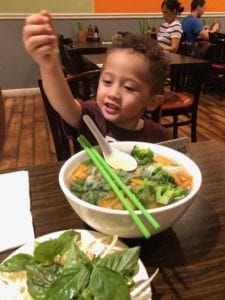As an Amazon Associate, I earn from qualifying purchases. This post may contain affiliate links. Read my disclosure policy.
Is your baby getting ready to start on solid foods, and you’re not sure where to start? Do you want to raise an adventurous eater, who loves a variety of flavors, textures, and veggies? Do you dread the thought of dealing with a picky eater?
It all starts with your baby’s first foods. Keep reading to see all of my tips on raising a foodie!
Raising a Foodie
Imagine your child a few years from now asking for a bowl of broccoli, choosing carrots for a snack, and eating the red curry you ordered at your favorite Thai restaurant, without throwing a tantrum! Trust me…it’s possible!
My 3-year-old son, Easton, is a typical boy who loves trucks, dinosaurs, and chasing girls around the playground. Not so typical? His love for vegetables and flavor-packed food. He enjoys sushi, pho, pad thai, malai kofta, and Japanese curry to name a few. While there are foods that he will pass on, he is always willing to try something new.
Here’s Easton eating a bowl of vegan pho. He is not vegan, or vegetarian. He sometimes eats meat, his favorites being chicken and hot dogs. But I am not exaggerating when I say that he LOVES vegetables. The bowl in front of him has rice noodles, broccoli, carrots, mushrooms, tofu, raw bean sprouts, lime, Thai basil, and hoisin in it.

A Culture of Picky Eaters
If you are shocked and amazed that my son willingly eats like this, you are not alone. We’ve been programmed in the United States to think that kids only like basic, bland, “meat and potatoes” type of food. In Korea, kids eat kimchee and in India, kids eat curry, so it’s obviously possible for our children to learn to eat all kinds of food.
American culture enables our children to be picky eaters. In fact, it almost seems like that’s the norm! How does this happen? Well, the food most Americans feed their babies is bland. They start off with tasteless cereals, and move on to vegetables blended with sweet fruits to mask the taste of the actual vegetable! Because these babies aren’t introduced to a variety of foods, spices, herbs, etc. at the prime time for their little taste buds to explore these flavors, they don’t develop a palate for them.
It’s a downward spiral from here. As they grow into tantrum-throwing toddlers, it’s sometimes easier to give in to what they want rather than to put up a fight. As a result, parents are often serving plain foods at home, and ordering mac-n-cheese and chicken fingers with fries (no green stuff on the plate, please) off the boring and unhealthy kids’ menu at restaurants.
You can avoid this pitfall by training your baby’s palate from the beginning. Your child can be an adventurous eater who loves veggies and loves flavorful food. Raising a foodie is within your reach!

Expanding your baby’s palate
It is possible to train your baby’s palate. What your child eats as a baby will form his flavor palate as a toddler and as a child. After months of drinking just formula or breast milk, your baby’s taste buds are pretty much a clean slate. (If you are breastfeeding, your baby has been exposed to the flavors of the food you have been eating through your milk.)
This is your time to influence his taste preferences. If raising a foodie is your goal, and you want your child to love everything from pad thai to a bowl of steamed broccoli, you have to introduce your baby to real, fresh, seasoned food from the beginning. And what’s the best way to do that? Yes, you guessed it…making homemade baby food!
Why make homemade baby food?
Homemade baby food is the only way to expose your baby to real food. Of course, a baby who is just fed jarred and packaged baby food will be perfectly fine. But have you ever tasted the stuff? It tastes nothing like real food. It’s processed multiple times to create a standard-tasting, shelf-stable product.
The stuff from the jar seems to taste extra sweet, always tastes the same, and is never seasoned. Your baby should experience variations of the taste (sometimes seasoned, sometimes not) and texture of food. This will teach him to expect a different experience when he eats, so he can learn to adapt to it. Translate that to toddler years…it’s okay to sometimes have steamed broccoli, and sometimes have Chinese stir-fried broccoli. They are both good!
I know making homemade baby food can sound daunting to some parents. I get it. Life is busy. Taking care of babies is hard. You barely even have time for yourself! But, making your own baby food is the foundation for raising a foodie. And trust me, it’s worth it!
It’s not as time-consuming as it may seem, and can easily be planned ahead and kept in the freezer.
Also, keep in mind that making your baby his own food will only be for a few months. By the time your baby is a year old (maybe even sooner), your baby should be eating table food (which means one meal for the whole family!).
The time and effort you put into making your own baby food is short-lived, but the benefits are endless.
When should I add spices to baby food?
First baby foods (stage 1 foods) are often baby cereal (rice, oatmeal, barely), whole milk yogurt, and single, pureed fruits and vegetables. Bananas, avocados, sweet potatoes, and carrots are good ones to start with.
But hear me out…their first bite does not need to be bland! You can start adding aromatic spices such as cinnamon, ginger, nutmeg, turmeric, cumin, coriander, paprika, etc. from day one. Allergic reactions to spices are very rare. Unless there is a spice allergy that runs in your family, it is pretty safe to say that your baby will not have a reaction. However, it is always best to consult with your baby’s pediatrician first.
It’s fun to experiment with different flavor pairings and to see how your baby reacts to them. If you need some inspiration, here’s a list of spice pairings for your baby food:
- baby cereal – ginger, allspice, cinnamon, pumpkin pie spice, nutmeg
- whole milk yogurt – cinnamon, pumpkin pie spice, turmeric
- pumpkin – cumin, ginger, pumpkin pie spice, nutmeg, cinnamon, turmeric
- sweet potato – cinnamon, allspice, pumpkin pie spice, clove, garlic
- carrots – ginger, turmeric, cumin, cinnamon, coriander, paprika, garlic
- peas – nutmeg, garlic, allspice
- beets – ginger, allspice, cumin
- apples – cinnamon, pumpkin pie spice, nutmeg
When should I add fresh herbs to baby food?
Just like adding spices, fresh herbs can be added to your baby food from day one. Some great herbs to introduce your baby to are: parsley, thyme, mint, cilantro, basil, sage, rosemary, and dill. Make sure to puree the fresh herbs with your vegetables at first, until your baby can handle more textures in his food. Again, experiment and have fun with this! Here’s a list of fresh herb pairings:
- avocado – cilantro, parsley, dill
- peas – dill, thyme, parsley, mint
- carrots – parsley, thyme, mint, sage, dill, rosemary
- sweet potato – sage, thyme, parsley
- pumpkin – sage, thyme, parsley, rosemary
- green beans – dill, rosemary, thyme
- zucchini – basil, mint, parsley
- mango – basil, mint, cilantro
When can I add more flavors and textures to baby food?
Once your baby is used to eating, you can introduce different textures and more complex flavors. This would be considered stage 2 baby food, which is appropriate for 6 to 8-month-old babies.
You can start adding grains and beans to their diet. Don’t be afraid to add healthy fats to their food, such as coconut milk, coconut oil, olive oil, etc. Babies need healthy fats for their brain development. You can also begin to introduce nuts and eggs to your baby, as long as it’s done in a safe way.
With the exception of salt, sugar, and honey, your baby can basically eat anything. Click here for some delicious and nutritious vegetarian stage 2 baby food recipes.

When can I introduce finger foods to my baby?
Once your baby can pick up food (or a spoon) and put it in his mouth, and he makes a chewing motion when eating thicker foods, you can offer him finger foods (around 8-10 months). These foods are very soft, so your baby doesn’t need teeth to chew them. Baby gums are very strong and do a good job of mashing food.
Finger foods can include sliced fruit (banana, very ripe peach, avocado, etc.), tofu, scrambled eggs, roasted or steamed vegetables (sweet potato, broccoli, carrots, etc.) Click here for some tasty baby finger food recipes.
What if my baby rejects certain foods?
Your baby may not like everything you feed him, and that’s okay. It’s very important to not force your baby to eat anything. It’s equally important to keep offering the food to him (unless he has an allergic reaction to it, of course). It can take up to 15 tries to develop a liking for flavors and textures.
You can also try to offer the foods that your baby doesn’t care for in different ways. Try different flavor combinations and textures to see if he likes it prepared a different way.
Creating a Good Eating Experience for Your Baby
When your baby takes his first bite of food, the whole experience will be strange and new to him. It is important to make it as fun and enjoyable as it can be so that he has a positive relationship with meal times, food, and trying new things.
Things like having a comfortable seat, good spoons, etc. can take the stress out of this new experience for both you and your baby. Check out this list of must-haves for feeding your baby.
Should I include my baby in family meals?
Yes! Your baby should absolutely, 100%, be included in your family meals! I know it’s sometimes easier to quickly feed your baby before your family eats, so everyone can enjoy their food in peace. (We all know how much work it is to feed and cater to a baby at the dinner table).
However, your baby needs to be sitting at the table with everyone else. He will learn how to eat, how to have good table manners, and how to pick up on social cues by watching everyone else.
Your baby will also be paying attention to what everyone else is eating, so make sure you are eating a variety of healthy and tasty foods!
Most importantly, it shows your baby that a meal can be a fun, social event. Creating a positive eating experience for your baby is an important foundation of raising a foodie.
How do I keep my baby interested in food?
Babies can sometimes become uninterested in food. It’s important to offer your baby a variety of tastes, flavors, and textures to keep him interested in eating. A good way to do this is to prepare a variety of food ahead of time and store it in the freezer. That way, it’s quick and easy to defrost a couple of different options to feed him.
Babies, just like adults, also eat with their eyes. A good rule of thumb is to “eat the rainbow.” Make sure to provide your baby with foods of all the colors nature has to offer. This not only ensures that your baby is getting a variety of nutrients, but it makes the food more interesting and visually appealing. It is also training him to eat this way in the future.
Letting your baby get messy is also a great way to keep him interested in food. Cleaning up the mess can be a pain, but your baby is just dying to get his hands dirty. He wants to feel the different textures of the food and practice getting it to his mouth. This is so important to your baby’s sensory development…not to mention it’s a lot of fun! So, let your baby explore!

Recap: Raising a foodie
Parenthood is hard enough. The last thing you need is for mealtimes with your baby to be hard. Here’s how to make it as easy as it can be:
- Spice it up! Add fresh herbs and spices to your baby’s food to introduce their taste buds to lots of flavors.
- Offer a variety of flavors, textures, and colors to keep things fun and interesting.
- Don’t force your baby to eat foods he doesn’t like right away, but keep offering them.
- Include your baby at the table so he can get the full dining experience, and can learn by watching others.
- Get messy! Encourage your baby’s sensory development by letting him touch the food and make a mess.
- Positive reinforcement! Celebrate when your baby tries new foods, and refrain from negative comments or attitudes when he doesn’t like something.
- Get the right gear. Here’s a list of baby feeding essentials.
I hope this article has given you some good ideas on how to expand your baby’s palate and provide a positive eating experience for him. Good luck on your journey of raising a foodie. I hope you enjoy every minute of it!
As always, sharing is caring! Please click on the buttons below to share this post with your friends!

Choosing the best food for babies to gain weight ensures healthy growth and proper nutrition during their early years
Foods like mashed bananas and boiled potatoes are excellent for including in a baby’s diet. These are staples in Indian kitchens and are perfect for helping babies gain weight.
Ragi porridge is a traditional Indian superfood and one of the best foods to help babies gain weight in a healthy and natural way.